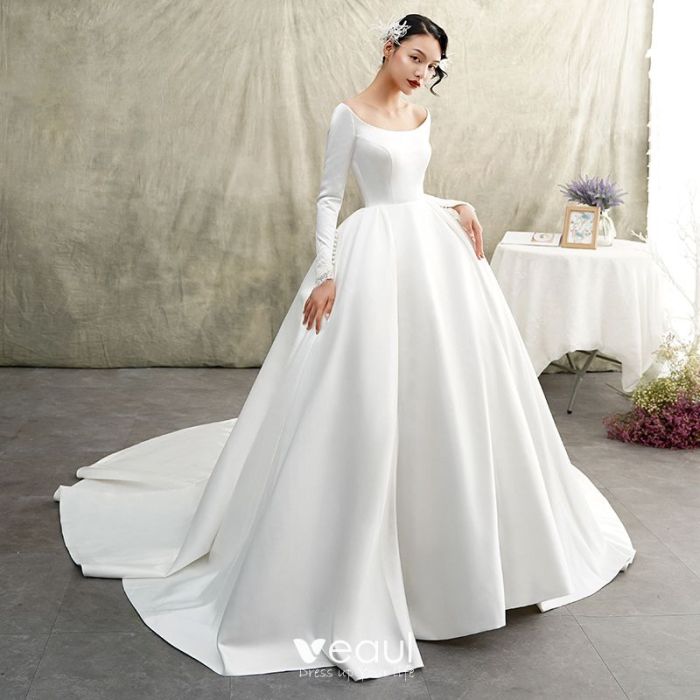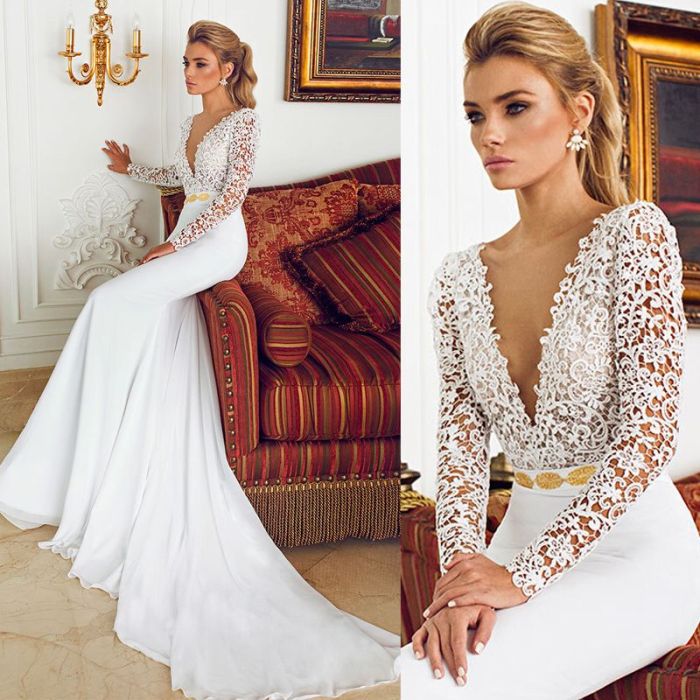Defining “Vintage” in Wedding Dresses
Vintage long sleeve wedding dress – The term “vintage” when applied to wedding dresses signifies a garment from a specific historical period, typically pre-1980s, possessing unique design elements reflective of its era. Defining the exact boundaries can be fluid, but generally, specific decades exhibit distinct characteristics. This section will explore the evolution of vintage wedding dress styles across different eras, examining fabric choices, construction techniques, silhouettes, and necklines.
Vintage Wedding Dress Eras and Their Defining Characteristics
The definition of “vintage” in wedding dress fashion spans several decades, each with its own unique aesthetic. Below is a timeline outlining key eras and their distinctive features:
- 1920s: The flapper era saw dresses with dropped waistlines, loose silhouettes, and embellishments like beads and fringe. Fabrics included lightweight silks, chiffons, and beaded fabrics.
- 1930s: This era favored bias-cut gowns, creating a sleek, form-fitting silhouette. Long, elegant lines were emphasized, often with delicate lace or subtle beading. Fabrics included silk crepe, satin, and lace.
- 1940s: World War II influenced a more streamlined aesthetic. Shoulder pads and fitted bodices were common, often paired with full skirts. Fabrics were often more utilitarian, such as wool crepe or simpler silks.
- 1950s: The post-war era brought full, cinched waists, often with petticoats to create a voluminous skirt. Lace, satin, and tulle were popular fabrics. This era is characterized by its romantic and feminine style.
- 1960s: The 60s saw a shift towards simpler, more A-line silhouettes, often with higher necklines and less embellishment. Lace, silk, and cotton were commonly used.
- 1970s: Bohemian and romantic styles emerged, featuring flowing fabrics, long sleeves, and often empire waistlines. Lace, chiffon, and floral prints were prevalent.
Evolution of Fabrics and Construction Techniques
Fabric choices and construction techniques evolved significantly across the vintage eras. Early vintage dresses often featured hand-stitching and intricate detailing, reflecting the craftsmanship of the time. The availability and use of different fabrics also changed. For example, the use of silk became more widespread in the later decades, while earlier dresses might utilize simpler materials.
Silhouettes and Necklines in Vintage Wedding Dresses
Silhouettes and necklines played a significant role in defining the style of each era. The 1920s favored dropped waistlines and loose silhouettes, contrasting sharply with the cinched waists and full skirts of the 1950s. Necklines ranged from high necks in the 1940s to plunging V-necks in the 1930s, reflecting the changing fashion trends.
Long Sleeve Styles and Their Evolution

Source: veaul.com
Long sleeves in wedding attire hold symbolic and cultural significance, often representing modesty, tradition, and elegance. Their styles have evolved significantly throughout history, reflecting the changing fashion trends of each era. This section will explore the symbolism, various long sleeve styles, and their evolution across different vintage eras.
Symbolism and Cultural Significance of Long Sleeves
Long sleeves in wedding dresses have often been associated with modesty and tradition, particularly in Western cultures. They can also symbolize protection, purity, and formality. The choice of long sleeves can contribute significantly to the overall aesthetic and feel of the wedding dress.
Different Long Sleeve Styles in Vintage Wedding Dresses
A variety of long sleeve styles appeared in vintage wedding dresses, each contributing to the unique aesthetic of the era. The following table details some of these styles:
| Era | Sleeve Style | Descriptive Details |
|---|---|---|
| 1930s-1940s | Long, Fitted Sleeves | Close-fitting sleeves that follow the arm’s contour, often extending to the wrist. |
| 1950s-1960s | Bell Sleeves | Fitted at the shoulder, widening gradually to a flared cuff at the wrist. |
| 1970s | Bishop Sleeves | Loose, full sleeves gathered at the shoulder and wrist, often with a slight puff at the shoulder. |
| 1920s-1930s | Long, Narrow Sleeves | Fitted and relatively straight, extending to the wrist. |
Changes in Sleeve Length and Style Across Vintage Eras
Sleeve length and style varied significantly across different vintage eras. The 1920s and 1930s often featured long, narrow sleeves, while the 1950s and 1960s saw a rise in bell sleeves and other more voluminous styles. The 1970s brought in looser, more flowing sleeves, reflecting the bohemian trends of the time.
Fabrics and Materials Used in Vintage Long Sleeve Wedding Dresses
The choice of fabric significantly impacts the overall look and feel of a vintage long sleeve wedding dress. Different fabrics possess unique properties that contribute to the aesthetic and drape of the garment. This section will explore common fabrics and embellishments used in these dresses.
Common Fabrics and Their Properties
- Lace: Delicate and intricate, lace adds a romantic and feminine touch. It comes in various patterns and textures.
- Silk: Luxurious and flowing, silk creates a sophisticated and elegant look. It drapes beautifully and comes in various weights.
- Satin: Smooth and shiny, satin offers a glamorous and sleek appearance. It reflects light beautifully.
- Crepe: A slightly textured fabric, crepe provides a more matte finish and excellent drape.
- Tulle: A sheer netting fabric, tulle is often used for overlays or to create volume in skirts.
Fabric’s Contribution to the Overall Aesthetic
The fabric choice significantly influences the overall aesthetic. For example, a lace dress evokes romance, while a satin dress conveys glamour. The weight and texture of the fabric also affect the drape and silhouette of the dress.
Common Embellishments
Vintage long sleeve wedding dresses often feature embellishments that add intricate details and visual interest. These include:
- Beading: Adds sparkle and texture, often creating intricate patterns.
- Embroidery: Adds delicate details and can be used to create floral motifs or other designs.
- Appliqué: Involves attaching decorative fabric pieces to the dress, creating dimensional effects.
Finding and Preserving Vintage Long Sleeve Wedding Dresses
Finding and preserving a vintage long sleeve wedding dress requires careful consideration and attention to detail. This section provides guidance on sourcing, authenticating, and preserving these unique garments.
Sourcing Vintage Wedding Dresses

Source: dhresource.com
Several avenues exist for sourcing vintage long sleeve wedding dresses:
- Vintage Shops: Specialised shops often curate collections of vintage clothing, including wedding dresses.
- Online Marketplaces: Sites like eBay and Etsy offer a wide selection of vintage dresses from various sellers.
- Consignment Stores: These stores often carry pre-owned designer clothing, potentially including vintage wedding dresses.
- Estate Sales: These sales can offer unique opportunities to find rare or one-of-a-kind vintage pieces.
Authenticating Vintage Wedding Dresses
Authenticating a vintage dress involves examining several factors:
- Construction Techniques: Hand-stitching, specific seam finishes, and the use of vintage materials can indicate age.
- Labels and Tags: Original labels and tags can provide information about the manufacturer and date of production.
- Fabric and Trims: The type of fabric and embellishments used can help determine the era.
- Style and Silhouette: The overall style and silhouette of the dress should align with the fashion trends of its purported era.
Proper Care and Preservation
Proper care and preservation are crucial for maintaining the condition of a vintage wedding dress:
- Cleaning: Professional cleaning by a specialist experienced in handling vintage garments is recommended.
- Storage: Store the dress in an acid-free archival box or garment bag in a cool, dark, and dry place.
- Repair Techniques: Minor repairs should be done by a professional conservator to avoid damaging the fabric.
Modern Interpretations of Vintage Long Sleeve Wedding Dresses
Modern designers frequently draw inspiration from vintage styles, incorporating elements of vintage long sleeve wedding dresses into contemporary designs. This section will explore how modern interpretations differ from their vintage counterparts.
Incorporation of Vintage Elements in Modern Designs
Modern designers often incorporate elements such as lace, long sleeves, high necklines, or specific silhouettes from various vintage eras. They might adapt these elements to create a contemporary look while maintaining the essence of the vintage style.
Comparison of Vintage and Modern Interpretations, Vintage long sleeve wedding dress
While modern interpretations often draw inspiration from vintage styles, there are key differences. Modern dresses might use more contemporary fabrics or construction techniques, and the fit and silhouette might be adapted for a more modern body shape.
Examples of Modern Dresses Inspired by Vintage Eras
Many contemporary wedding dresses reflect vintage influences. For example, a dress might feature the long, fitted sleeves of the 1940s but be made from a modern, lightweight fabric. Another might incorporate the full skirt of the 1950s but with a more contemporary neckline.
Illustrative Examples of Vintage Long Sleeve Wedding Dresses
This section provides detailed descriptions of three distinct vintage long sleeve wedding dresses from different eras, highlighting their unique features, fabric choices, silhouettes, and overall aesthetic.
Example 1: 1920s Flapper-Inspired Gown
Imagine a 1920s gown in ivory silk chiffon, featuring a dropped waistline, long, narrow sleeves, and delicate beading along the neckline and hem. The silhouette is loose and flowing, reflecting the era’s carefree spirit. The overall aesthetic is one of elegant simplicity with subtle sparkle.
Example 2: 1940s Wartime-Influenced Dress

Source: cloudfront.net
Picture a 1940s dress in cream wool crepe, with a fitted bodice, long, fitted sleeves, and a slightly full skirt. The dress features a high neckline and minimal embellishment, reflecting the more utilitarian aesthetic of the time. The overall impression is one of understated elegance and practicality.
Example 3: 1970s Bohemian Gown
Envision a 1970s gown in off-white lace, with long, flowing bishop sleeves and an empire waistline. The dress features delicate floral embroidery and a romantic, bohemian aesthetic. The overall impression is one of effortless grace and free-spirited charm.
Impact of Color and Accessories
The choice of color, such as ivory, off-white, or cream, significantly impacts the overall look. Accessories, including veils, headpieces, and jewelry, complement the dress and enhance its vintage aesthetic. For example, a simple pearl necklace might complement a 1940s dress, while a flower crown might suit a 1970s gown.
FAQ Corner
How can I determine if a vintage wedding dress is authentic?
Authenticating a vintage dress requires careful examination of construction techniques, fabric types, and potential maker’s marks. Consulting with a vintage clothing expert or appraiser is recommended.
What are the best ways to clean a vintage wedding dress?
Dry cleaning by a specialist experienced in handling delicate vintage fabrics is crucial. Avoid harsh chemicals or home cleaning methods.
Where can I find affordable vintage wedding dresses?
Online marketplaces like eBay and Etsy, along with local consignment shops and vintage boutiques, offer diverse options at varying price points.
How do I store a vintage wedding dress properly?
Store in a cool, dry, dark place, ideally in an acid-free archival box or garment bag to prevent damage from light, moisture, and pests.
